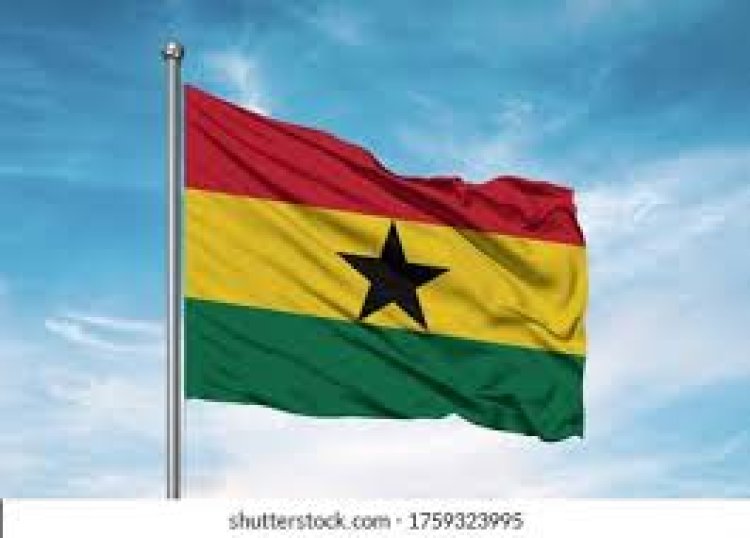At the 67th Independence Day anniversary celebration held at Koforidua Youth Resource Centre in the Eastern Region of Ghana, I approached a student who was proudly displaying a flag in his hand with the colours red, gold, green and a black star embossed in the middle.
I asked him: what flag are you holding? He confidently answered that this is the Ghana national flag. I asked again: are you really sure you are holding and displaying the Ghana national flag?
He stared at me with bewilderment and replied, Madam, please, you are dressed as a Ghanaian, speaking a Ghanaian dialect and you can’t recognise the Ghana national flag? Hmmm, I became dumbfounded.
I then said to him, “albeit what you are holding looks like the Ghana national flag, it is not!
The Ghana flag's official design has a black star well positioned in the centre of the gold horizontal stripe with three out of the five-pointed touching the end of the gold horizontal stripes (one between the gold and red at the top, and two between the gold and green at the bottom).
An example of a wrong standard of the Ghana national flag.
A worrying concern today is how the Ghana flag is produced/manufactured without attention paid to the required official standard design—colour scheme and also hoisted not according to the approved protocol.
The Ghana flag is a national symbol that gives identity and instils national pride and unity in Ghanaians all over the world. Yet, despite the significance of the Ghana national flag, attention is not given to its production and usage.
The Ghana flag was designed by a renowned Ghanaian artist, Mrs. Theodosia Salome Okoh. It was first introduced on 6th March, 1957, during the independence celebration in replacement of colonial British Gold Coast's Blue Ensign.
The flag was flown until 1964 and it was then reinstated in 1966. The flag of Ghana was designed to consist of the Ethiopian Pan-African colours of red, gold and green all arranged in three horizontal stripes with a black five-pointed star in the centre of the gold stripe.
The Ghanaian national flag was the second African flag after the flag of the Ethiopian Empire to adopt these colours, though the colours are inverted.
The red in the flag represents the blood our forefathers who led and died in the struggle for independence from the British colonial masters.
The red colour is also interpreted to stand for the love of the Ghanaian nation. The gold represents the nation’s abundant mineral resources.
The abundant gold in the land of Ghana gave her the initial name Gold Coast, which was later changed to the current name Ghana upon independence in 1957. Aside from gold, Ghana has other mineral resources such as diamond, manganese and bauxite.
The green symbolises the rich forests and natural wealth. Ghana is rich in green vegetation which provides the nation with cocoa, timber, oil, food and shea butter. The black star in the middle of the gold is a symbol of Africa's emancipation from slavery and unity against colonialism.
As Ghana was the first country south of the Sahara in Africa to gain independence from colonial rule, the black star was the symbol in the flag to inspire other African countries to also fight for their freedom from their white colonial masters.
As declared to the world by Dr. Kwame Nkrumah, the first Ghanaian President, “Today, from now on, there is a new African in the world! That new African is ready to fight his own battles and show that after all, the black man is capable of managing his own affairs… We have awakened. We will not sleep anymore.”
Dr. Nkrumah made it clear that “our independence is meaningless unless it is linked up with the total liberation of Africa.” As a Pan-Africanist, he envisioned Ghana’s independence as inspiring a total liberation of Africa that affects all black generation. The Ghana national football team’s name, “Black Stars,” also originated from it.
Today the Ghana flag is one of the important national symbols that gives national identity to Ghanaian citizens all over the world. It fosters a sense of unity and pride among Ghanaians and stimulates feelings of nationalism and remembrance of rich historical events to freedom and emancipation.
The Ghana flag is hoisted and flown in the sky to grace significant national occasions and ceremonies such as Ghana Independence Day (6th March) and sporting contests.
The flag is lowered to fly halfway when tragedy hits the country. For instance, in July 2012, when the then sitting President of Ghana, Professor John Evans Fiifi Atta Mills, passed on, the flag of Ghana was lowered halfway as the nation mourned him.
As the pride of the nation, the Ghana flag is hoisted at all important government offices and buildings including the Parliament House, the Supreme Court and the seat of government,Jubilee House. Despite the significance of the Ghana flag, attention is not given to its official design standard, the protocol involved in the display and also required fabric for the specific flag used in production.
For example, the fabric for outdoor flag is unique to enable it to fly on the pole. I see outdoor Ghana flags with difficulty flying even when the wind blows due to the heavy nature of the fabric used in production.
From my observation, several Ghana flags hoisted at government and non-government offices are not to the required design standard and approved protocol.
The general rule is that “the national flag should be flown in the position of honour, and not in an inferior position to any other flag (although some countries make an exception for royal standards)”. Other protocols include:
“When a national flag is displayed together with any other flags, it must be hoisted first and lowered last.
When a national flag is displayed together with the national flags of other countries, all the flags should be of approximately equal size and must be flown at an equal height, although the national flag of the host country should be flown in the position of honour (in the centre of an odd number of flagpoles or at the far right — left from an observer's point of view — of an even number of flagpoles).
When a national flag is displayed together with flags other than national flags, it should be flown on a separate flagpole, either higher or in the position of honour.”
It is disheartening to see the Ghana national flag displaced not in a position of honour in our homeland amidst other national flags, patriotic Ghanaians using and display Ghana flags proudly but unfortunately not the Ghana flag.
I have some thought-prompting questions in my mind now.
I want to know which institution in Ghana is responsible for the manufacturing and production of the Ghana flag.
Which institution is responsible for giving accreditation to companies and individuals for the production of the Ghana flag?
Which institution is in charge of regulating and monitoring the production of the Ghana flag to ensure that the right standards are met? Which institution is responsible for ensuring that the protocol involved in the proper display of the national flag is adhered to?
As we celebrate our 67th Independence Day anniversary and observe the Heritage Month 2024, we have to reflect on our rich history, and assess the present to preserve our national heritage for generations yet unborn.
I urge all Ghanaians to start correcting the wrong by replacing all substandard Ghana flags with the required designed, red, gold, green and a black star well positioned in the centre of the gold horizontal stripe with three out of the five-pointed touching the end of the gold horizontal stripes (one between the gold and red at the top, and two between the gold and green at the bottom).
As a patriot Ghanaian, I encourage you to begin to inspect the flag on your office table, in front of your office flying on the pole, at hotels, at national/officials gatherings, and anywhere you see a Ghana flag whether it meets official standards. As we do this we are upholding “in high esteem our heritage, won for us through the blood and toil of our fathers”. My carrion call today ohh!!
“Arise, arise, O sons of Ghanaland, And under God march on for evermore. Raise high the flag of Ghana Black star of hope and honour,
To all who thirst for liberty;
Where the banner of Ghana freely flies” And together we make our nation Ghana great and strong!!! God Bless our homeland Ghana!!!
The writer, Mrs Elizabeth Dankwa Yeboah, is a PhD. Student at the University of Ottawa, Canada.



 Freeman Koryekpor
Freeman Koryekpor 



































